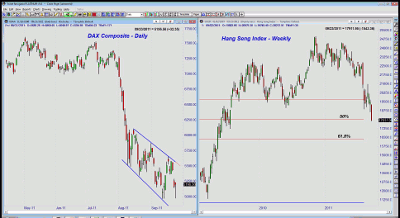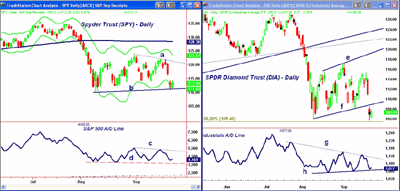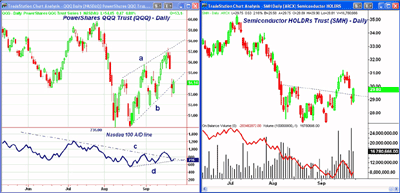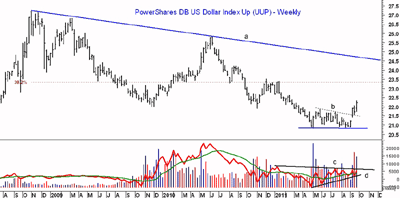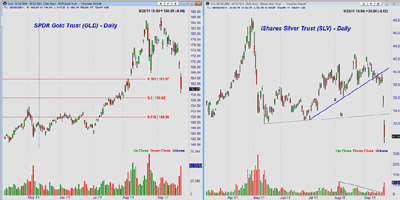Bearish sentiment and economic troubles continue to take their toll on the markets, but certain sectors look good and a buying opportunity may be right around the corner, writes MoneyShow.com senior editor Tom Aspray.
Even though global stock markets were able to stabilize on Friday, the sharp declines last week added to the overwhelming negative sentiment in the markets.
The technical formations prior to last week suggested that stocks were vulnerable to decline, and the short-term outlook turned more negative Tuesday.
Of course, the magnitude of the decline was a surprise to all, and Thursday's sell-off was similar to the panic selling that occurred in early August. This gave the investment firms and major banks some vindication, as they have been racing each other for weeks to cut their forecasts for the economy and lower their year-end targets for the S&P 500.
Even the Federal Reserve joined in, as their new plan to lower long-term rates was accompanied by the comment that there are "significant downside risks to the economic outlook, including strains in global financial markets," something that undoubtedly spooked an already skittish market.
Though I think the Fed’s concern is valid, the general consensus of economists makes me more skeptical. Many believe that if we are not already in another recession, we will be soon. If this turns out to be the case, it would be the first recession that was predicted by most as it was occurring.
These predictions comprise the majority of market sentiment, even though last week’s housing data was better than expected; existing home sales jumped 7.7% in August. Nevertheless, a survey of 100 economists painted a bleak picture of housing, as they expected prices to drop 2.5% this year, and then only rise 1.1% through 2015.
In my experience in the market, the majority is rarely right. When you have a consensus view—especially one that persists for some time—I always look at the technical evidence to see whether it supports this consensus.
For example, my volume analysis on gold turned positive in 2006, but sentiment toward gold was often mixed. In the fall of 2009, however, public sentiment on gold was overwhelmingly positive, right before gold topped out on December 1.
This began a months-long decline. The correction was severe enough to turn enough of the bulls negative on gold, which created another good buying opportunity.
Therefore, while the short-term outlook for the global equity markets is decidedly negative (as I detail later), I think by year's end the stock market may surprise many of the current bears.
Of course, the problems with the US economy and our leadership are just magnified overseas. Many are suggesting that the Eurozone will eventually break up, as their leaders fail to comprehend the severity of their debt problems.
The focus remains primarily on Greece, but the contagion fear is still hurting the markets. The economic news last week was also grim, as the Eurozone purchasing managers' index dropped in September for the first time in two years. Rating agencies downgraded many Italian and Greek banks, which did not help. (I would love to see someone start rating the rating agencies.)
Late last week, the G-20 announced that it would take “all necessary action” to shore up the banks and financial markets. I think they will eventually figure out the necessary actions and move accordingly.
Unlike the US stock market, the German Dax Composite has continued to decline after the sharp drop in late July. The Dax was sharply lower early last Friday, but closed higher, and could have formed a very-short-term bottom.
Things weren’t that much better in Asia, as selling was heavy. News that China’s factory activity declined in September reversed some of the positive sentiment that had been building for their economy.
The Hong Kong Hang Seng Index had a rough week, down 7.9%, and as the chart shows, the long term 50% Fibonacci support was broken. The 61.8% support stands at 16,544, which is 7.5% below Friday’s close.
The market is likely to get a good test from the economic data this week. On Tuesday, we get new-home sales figures, the S&P Case-Shiller Housing Price Index, and the latest readings on consumer confidence.
Wednesday will bring the latest numbers on durable-goods orders, followed Thursday by the final reading on second-quarter GDP, jobless claims, and pending home sales.
On Friday, we get the numbers on personal income and consumer sentiment, which is likely to be watched closely by Wall Street.
NEXT: What to Watch
|pagebreak|WHAT TO WATCH
The sharp drop last week pushed many of the market indicators to levels where a sharp rebound is likely. The odds would have been even greater if stocks had been sharply lower again on Friday.
Some charts show potential double bottom formations, and while the volume action does support this view, the evidence is not strong enough to act. Given the overhanging political and economic problems, a new trading range is more likely.
I still think the current decline will be an opportunity to establish long stock positions in some of the sectors that I like, but we need to see a decrease in downside momentum first. Technology and cash-rich, high-dividend stocks are my favorites, followed by the retail sector, as I do not think Christmas shoppers will stay away.
S&P 500
The Spyder Trust (SPY) is holding above the August lows as it is testing the daily Starc- bands. Last Thursday's gap lower opening took out the prior lows at $114.05.
If the August lows are broken, then the 127.2% Fibonacci target from the flag formation is at $106.50, while the width of the flag gives downside targets in the $104 to $105 area.
First resistance stands at the gap in the $114.21 to $116.27 area, with stronger levels at $118.50. The daily trend line resistance is at $121.50.
.
The S&P 500 A/D line is so far holding above both the recent lows and those that were made in August (line d). This is an encouraging sign, but a move through the downtrend (line 3) is needed to confirm a bottom.
Dow Industrials
The Spyder Diamonds Trust (DIA) came very close to the 38.2% support of $105.46 last week, as DIA gapped though the lower boundary of the flag formation (line f) on Thursday.
There is resistance now at $107.95 to $110.69, with a key level to follow at $114 to $115.25.
The Dow Industrials A/D is diverging from prices (line h), but needs a move through the resistance (line g) to confirm the divergence. A convincing break of this support will indicate a further decline.
Nasdaq-100
The PowerShares QQQ Trust (QQQ) also gapped lower Thursday, then closed back above the uptrend (line b) on Friday, which is positive.
It would take a close below the September 6 lows at $51.91 to signal a test of the August lows.
The Nasdaq-100 A/D line overcame its downtrend (line c) last week, which suggests the A/D line could be bottoming. The A/D line shows a slight uptrend (line d) which could be broken on a further decline. A move in the A/D line above last week’s high would be positive.
There is resistance now at the gap in the $54.46 to $55.37 area.
In a recent article, I took a close look at not only the PowerShares QQQ Trust (QQQ), but also the Select Sector SPDR Technology (XLK), Semiconductor HOLDRs Trust (SMH), and Apple (AAPL).
Sector Focus
All of the major sectors were hit hard last week, and three—energy, materials, and industrials—look the weakest.
The Select Sector SPDR Utilities (XLU) is holding first support in the $32.70 to $33 area, and a drop back to the $32 to $32.40 area should be a buying opportunity.
The Select Sector SPDR Consumer Staples (XLP) and Select Sector SPDR Health Care (XLH) are also holding well above their highs, but the short-term momentum is still negative.
Oil
November crude plummeted as expected last week. The support at $85 and the $83.20 level both gave way, with crude hitting a low of $77.55 on Friday.
This could be a final washout, but it will take some time for the market to recover from a $13-plus drop.
There is initial resistance at $82, with stronger levels in the $84 to $85 area.
NEXT: The Dollar, Metals, and Tom's Outlook
|pagebreak|The Dollar
The Powershares DB Dollar Index Up ETF (UUP) appears to have completed a major bottom, as it has held well above the breakout level (line b).
The next resistance is in the $22.50 area, with the major 38.2% retracement resistance at $23.30. The long term downtrend (line a) is in the $24.70 area.
The weekly on-balance volume (OBV) tested its uptrend (line d) and has turned higher. A move above the resistance (line c) would be very positive.
There is initial support now at $22, with stronger support sitting in the $21.50 to $21.80 area.
Precious Metals
The negative divergence in the weekly OBV on Spyder Gold Trust (GLD) warned of a decline, and we really got it—GLD closed down 9.2%, dropping more than $16.
It is already close to the first good level of support, though, with the minor 50% retracement support level at $156.82. The minor 61.8% retracement support is at $149.98, which should be the maximum downside for the correction.
There is resistance for GLD now in the $164 to $168 range.
I have expecting for some months to see a sharp drop in silver, as I thought it was being bought primarily by those who missed the initial rally. The chart of the iShares Silver Trust (SLV) shows two breakaway gaps after failing to close back above the $40 level once support (line a) was broken.
The May lows (line b) were also clearly broken, and this market, like gold, will need some time to recover. Silver looks much more vulnerable to further weakness than gold.
The Week Ahead
This week should be pretty interesting, as some market sectors (like technology) look pretty good, while others (like the small caps) look very weak.
Typically, I would expect a further oversold bounce, and then the ranges should narrow before a sustainable rally can develop. This may not happen this time, and the PowerShares QQQ Trust (QQQ) should be watched closely for signs that the worst of the selling is over.
I hope you raised some cash (as suggested last time) before the market plunged. I continue to think that we are going to get a good opportunity in the next week or two. In addition to the technology sector, I like the retail apparel group, as well as some of the cash-heavy high dividend and drug stocks.
I would not sell out your gold positions at current levels, as the majority of the decline is likely behind us.
Don’t miss Tom’s latest Trading Lesson, Unlocking Chart Secrets with Volume
